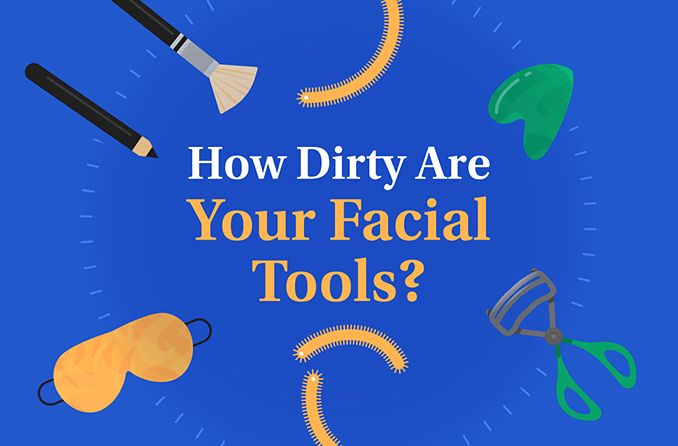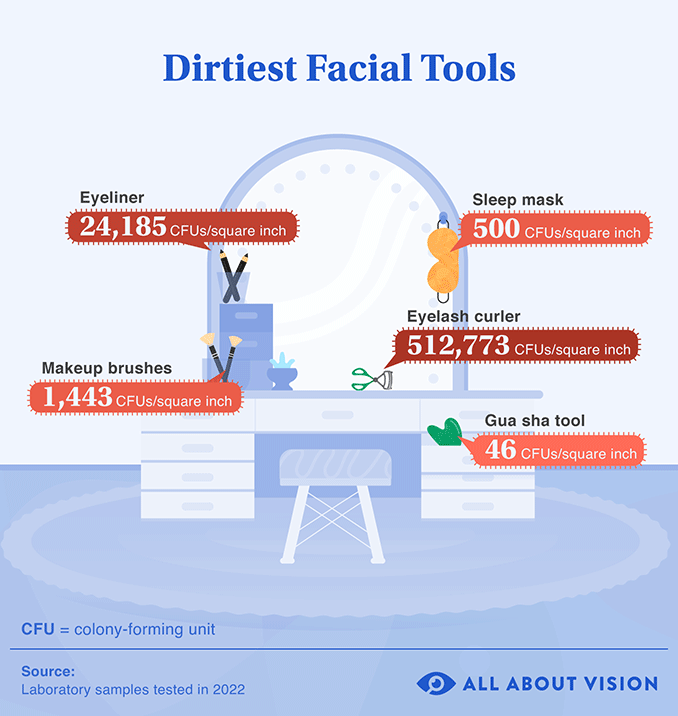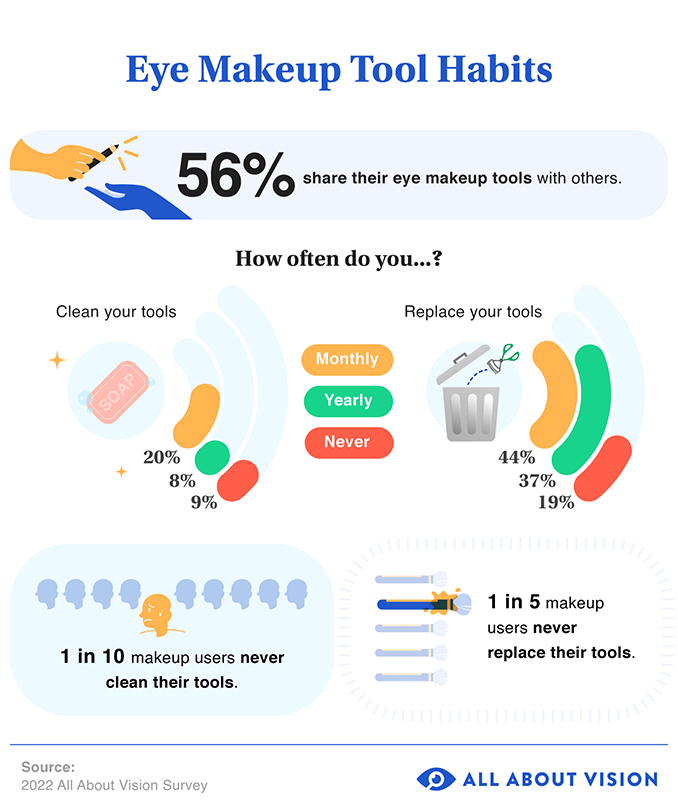How dirty are your facial tools?

Is your eyelash curler dirtier than a kitchen sink? [Study]
From makeup brushes to eyeliner and beauty blenders, there are a ton of beauty products that get pretty close to your eyes. But have you ever thought about how clean these products are? We decided to investigate and swab common beauty products like eyelash curlers and eyeshadow brushes to see the number of germs they accumulate. Could your eyeliner brush be dirtier than a toilet seat? Does your sleep mask carry harmful bacteria? Let’s find out.
Key Takeaways
Eyelash curlers were the eye makeup tools with the most germs.
Sleeping masks have four times more bacteria than a bathroom faucet handle.
56% of makeup users share their tools with others — 1 in 10 never clean their tools, and 1 in 5 never replace them.
An exploration of eye makeup tools
We’ve probably all heard about the importance of regularly cleaning our beauty brushes, but how important is it really? And what could happen if you don’t? We wanted to find out exactly how dirty these tools get by swabbing five commonly used beauty products that go on or near the eyes and comparing the amount of germs and bacteria found on them. Spoiler alert: They were all a lot dirtier than we expected.
Does beauty equal germs?
To start, we looked at eye makeup tools that were part of a daily routine: makeup brushes (for eyeshadow), eyelash curlers, eyeliner pens, sleep masks and gua sha tools. After swabbing each item, we compared the amount of colony-forming units (CFUs) on each one. Get ready to be grossed out.
Of all the products tested, we found two main types of bacteria: bacilli and gram-positive cocci. Eye infections from bacilli bacteria can cause redness, inflammation and, in the worst cases, blindness. Cocci, another family of harmful bacteria, includes Staphylococcus — the one responsible for staph infections. Getting cocci bacteria in your eye can lead to irritating conditions like pink eye or keratitis (inflammation of the cornea).
The CFU number indicates how much bacteria was present in a given area. The gua sha tool— a smooth, curved stone that may reduce lines and wrinkles when used on the face — was the cleanest, with only 46 CFUs per square inch. The dirtiest item by far was the eyelash curler, which was host to over half a million CFUs.
Would you put that near your eyes?
To better conceptualize these bacteria levels, we compared them to other everyday household objects that most people would expect to be riddled with bacteria. We were shocked by how clean these items were by contrast.
All of the facial tools we tested were dirtier than a toilet handle, and more than half of them were more contaminated than a toilet seat. The eyeliner pencil was home to more than twice the bacteria of a pet’s food bowl, and the eyelash curler had 24 times more bacteria on it than the dirtiest household item: the kitchen sink. Are you rushing to clean your makeup tools yet?
Keeping things clean
If you’ve never cleaned your eyelash curler, you’re not alone! Who knew they were such a source of germs? To find out how often people clean or replace their facial tools, we polled over 500 makeup users on their beauty tool hygiene habits.
Over half (56%) of makeup users reported sharing their beauty tools with someone else — a big mistake, especially for items that come in close contact with your eyes. Bacteria from dirty facial tools can result in poor eye health that may affect your vision, so never use others’ devices. Cleaning makeup brushes often is also important because bristles can trap loads of bacteria. In fact, the American Academy of Dermatology Association suggests putting them through a seven-step cleaning process every seven to 10 days.
In addition, we learned that one in five makeup users never replace their facial tools. Furthermore, one in 10 people reported never cleaning their makeup tools either. While most people we surveyed said they wash their tools at least monthly, we hope those who shared their tools with others did it more often.
Blocking bacteria
While the amount of bacteria we found on common facial tools is alarming, it’s important to note that proper tool maintenance can keep them at a safe level. Replacing tools every so often is also key because, at a certain point, cleaning won’t get rid of all the bacteria that builds up over time. To help prevent infections, be especially diligent about the tools you use on or near your eyes. You wouldn’t want to touch your eye to a toilet seat, now would you?
Methodology
For this study, we conducted 10 gram and stain culture swab tests for five different items: an eyeshadow brush, an eyelash curler, an eyeliner pencil, a sleep mask and a gua sha tool. Each item was swabbed two different times, and colony-forming units were averaged per item. Additionally, we surveyed 564 people who regularly wear eye makeup about their habits and practices.
About All About Vision
Here at All About Vision, we make it easy to keep your vision clear and your eyes healthy. We’re dedicated to providing you with up-to-date information on all things vision and access to local eye care professionals in your area.
Fair Use Statement
Do you or someone you know have questionable makeup hygiene habits? Feel free to share this article with your friends. We just ask that you do so for noncommercial purposes and you link back to this page.
Page published on Wednesday, July 20, 2022









